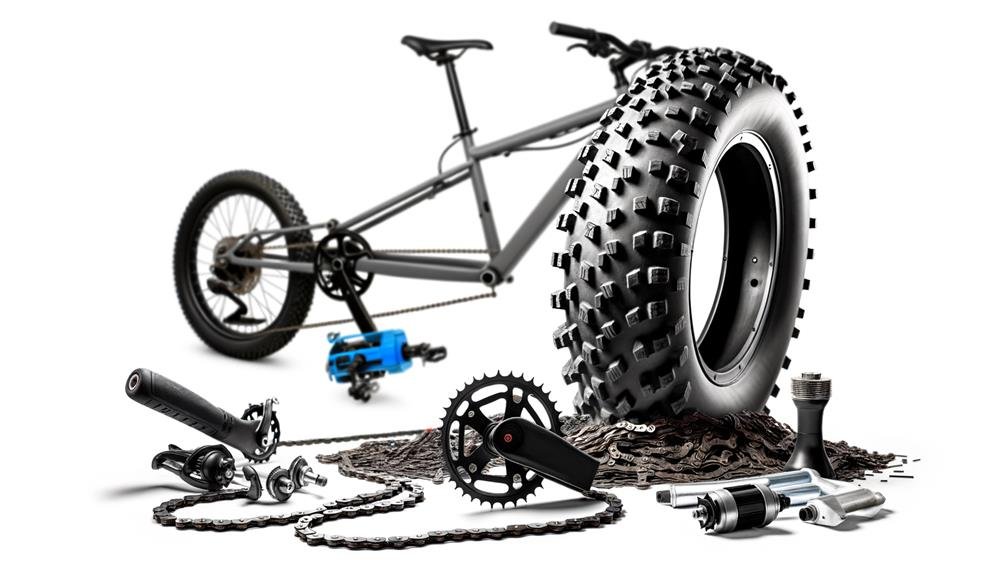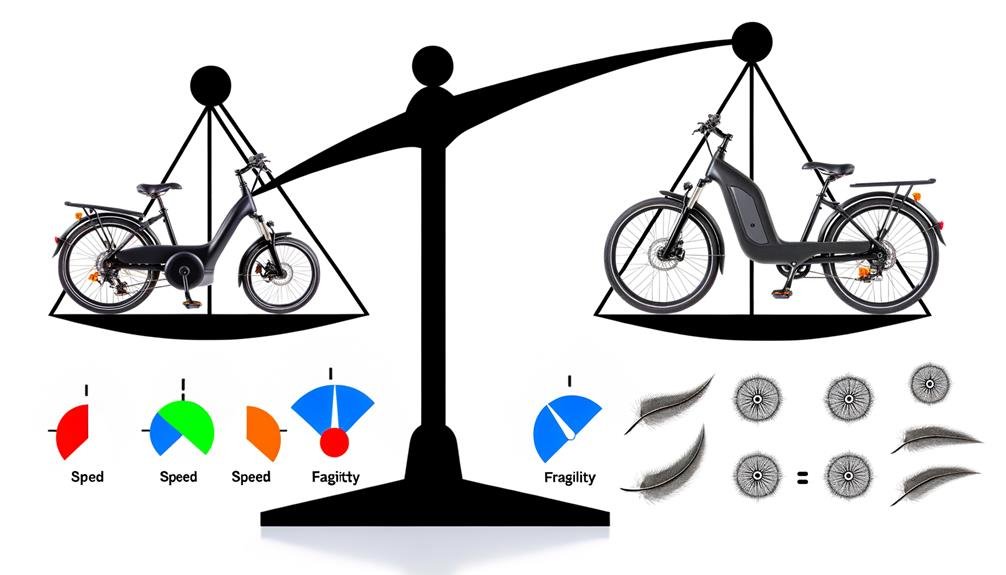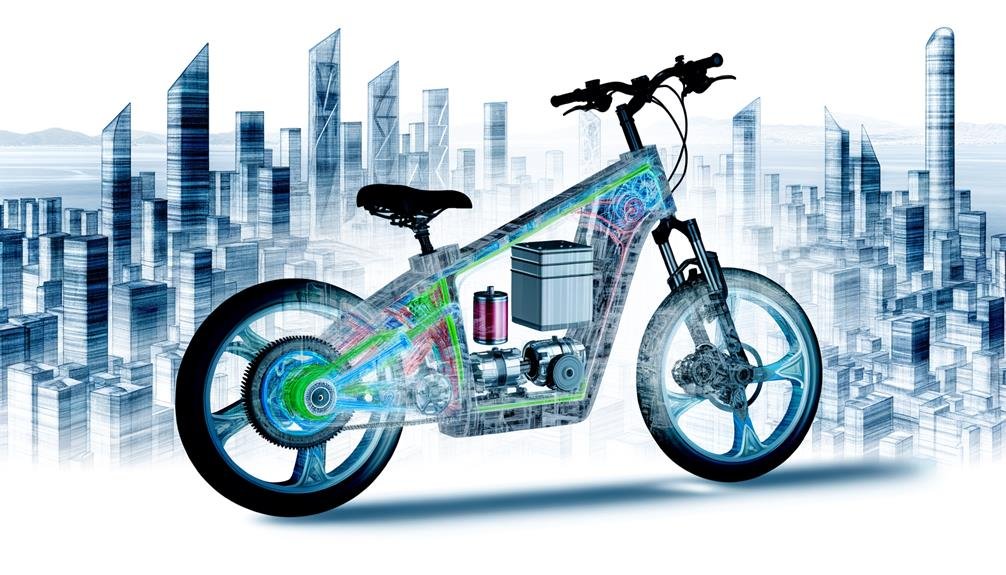Charles Miller is a veteran bike enthusiast with over 12 years of experience dealing with bikes as a mechanic. Despite immense love and expertise for...
We've ridden them, we've admired them, and we've felt their surprising heft. Electric bikes, or e-bikes as they're commonly known, are undeniably heavier than their traditional counterparts.
Have you ever wondered why that is? There's a lot more to it than just the addition of a motor and battery. The weight of these modern marvels is influenced by a multitude of factors, each playing its own role in the grand scheme of things.
Strap in, as we're about to embark on an enlightening journey to uncover the reasons behind the significant weight of e-bikes.
- Key Takeaways
- Understanding E-Bike Components
- The Impact of the Battery
- Role of the Electric Motor
- Importance of Robust Tires
- Reinforced Frame and Parts
- How Weight Influences Rides
- The Trade-Off: Power Vs Weight
- Lighter E-Bikes: Pros and Cons
- E-Bike Weight Comparisons
- The Future of Lightweight E-Bikes
- Frequently Asked Questions
- Conclusion
Key Takeaways
- The battery is the heaviest component of e-bikes and manufacturers are trying to reduce its weight without sacrificing power.
- Advances in battery technology, such as lithium-ion, lithium-polymer, and solid-state batteries, are helping to reduce weight.
- The electric motor can also contribute to the weight of an e-bike, with mid-mounted motors offering better efficiency and balance.
- Robust tires and reinforced frames and parts are necessary to handle the weight and power of the e-bike components, ensuring a stable and controlled ride.
Understanding E-Bike Components
Let's dive into the five primary components of an e-bike that contribute to its significant weight:
- The electric motor is a key component that adds to the overall weight, typically ranging up to 17.6 lbs depending on its type and power. It's a crucial part of the e-bike's functionality, providing the necessary propulsion for an effortless ride.
- Next, we can't overlook the battery. High-capacity lithium-ion batteries are common in e-bikes, often tipping the scales at around 38 lbs. This component is crucial in storing and supplying the electrical power needed to run the bike.
- The display and control system, though not as hefty as the motor or battery, still contributes to the weight. This system, which includes sensors and wiring, allows us to monitor and control our e-bike's performance.
- Special tires meant for off-road use add extra pounds to the bike. Their wider construction increases traction but also weight.
- Lastly, the frame construction, usually made of durable steel, supports the weight of the motor and battery. This necessary sturdiness also adds to the overall heft of the e-bike.
The Impact of the Battery
We're now turning our attention to the significant role that the battery plays in the overall weight of electric bikes.
It's not just the battery's weight contribution that's noteworthy, but also the impact of battery size and the ongoing advances in battery technology.
Through exploring these points, we'll better understand why e-bikes are heavier than traditional bicycles.
Battery Weight Contribution
Diving into the specifics, the lithium-ion battery, a common component in electric bikes, packs quite a punch when it comes to weight, with high-capacity ones tipping the scales at around 38 lb. This battery weight contribution is a critical reason why electric bikes are heavier. It's the heaviest part of these bikes, and manufacturers often struggle to combat this weight without sacrificing power.
Here's a quick rundown:
| Component | Contribution to Weight | Impact |
|---|---|---|
| Battery | Heaviest | Significant |
| Motor | Varies | Moderate |
| Frame | Lightest | Minimal |
This table highlights the battery weight as the predominant factor. The motor and frame, though contributing, can't match the battery's impact. In essence, understanding these components gives us a better understanding of the weighty issue at hand.
Battery Size Considerations
Having established the pivotal role of the battery in contributing to the weight of electric bikes, it's important to further analyze how the size of the battery impacts the bike's overall weight and performance.
Battery size considerations are crucial, as high-capacity lithium-ion batteries can weigh up to 38 lbs, significantly increasing the overall heaviness of the e-bike. This weight contributes not only to the bike's total mass but also affects its balance and handling, shaping the riding experience.
When we combine the weight of the motor and battery, it's clear that larger batteries provide extended range and power, but at the cost of added weight and potentially diminished maneuverability.
Hence, the rider must strike a balance between battery size, bike weight, and desired performance.
Advances in Battery Technology
While the size of the battery plays a significant role in the weight of electric bikes, advances in battery technology have also made a substantial impact, allowing for lighter, more energy-dense batteries. This is especially beneficial for electric mountain bikes, where weight can significantly affect performance.
Key advances in battery technology include:
- Development of lithium-ion batteries: These are lighter and offer more energy than traditional lead-acid batteries.
- New chemistries like lithium-polymer and solid-state batteries offer further weight reductions.
- Advanced battery management systems (BMS): These improve efficiency and performance, reducing weight without compromising power.
- Ongoing research and development: Aimed at creating lighter, more compact batteries.
These developments not only reduce weight but also enhance the electric motor and motor system's effectiveness, preventing us from running the battery flat quickly.
Role of the Electric Motor
When examining the role of the electric motor, it's crucial to note that it can weigh up to 17.6 lb, depending on its type and power output, significantly contributing to the overall weight of the bike. This is why many electric bikes are heavy, as they typically employ either a mid-mounted motor or a hub motor.
Mid-mounted motors are generally more efficient, and they provide better balance for handling, thanks to their central placement. They're often heavier than hub motors, thus adding to the bike's total weight, but the excellent weight distribution they offer can't be overlooked.
On the other hand, hub motors, usually positioned in the wheel's hub, may be lighter but could affect the bike's balance and stability due to their peripheral placement.
We must understand that the weight of the motor isn't just about the physical mass; it also relates to the power output. A heavier motor might deliver more power, contributing to faster speeds or better uphill performance.
Importance of Robust Tires

Beyond the significant contribution of the electric motor to the bike's weight, the robust nature of electric bike tires also plays a crucial part. Bike manufacturers often equip heavy e-bikes with robust tires due to their capacity to handle heavy loads and withstand stress from heavy-duty components.
The construction of robust tires involves these critical features:
- Use of a harder compound to reduce rolling resistance, enhancing the overall performance and efficiency of heavy e-bikes.
- High resistance to wear, serving well on various surfaces, and offering better puncture resistance.
- Added stopping power due to their robust nature, contributing to the safety of the rider while bearing the e-bike's weight limit.
These features aren't just technicalities. They connect us, the riders, to our bikes, enhancing our sense of belonging. We can trust that these tires can handle the load, regardless of the e-bike's weight.
Reinforced Frame and Parts
Another significant factor contributing to the heft of electric bikes is the reinforced frame and parts, specifically designed to support the additional weight of the motor and battery system. These bikes are typically heavier than regular bikes due to the addition of these robust elements.
When adding a motor and battery system, it's crucial to ensure the bike's frame can handle the additional strain. This is where the use of Carbon Fiber comes in. It's not only sturdy but also lightweight, making it an excellent material for reinforcement. However, even with the use of Carbon Fiber, the overall structure still turns out heavier due to the need for more robust parts.
Elements like the suspension and brakes are generally heavier-duty to cope with the increased weight and power. This additional reinforcement ensures the bike can manage the power output and weight without sacrificing performance or safety.
While the reinforced frame and parts contribute to the bike's overall weight, they also make for a more stable, controlled ride. Yes, e-bikes are heavier, but they're also more reliable, offering us the durability and longevity we need for our various riding experiences.
How Weight Influences Rides

Delving into the impact of weight on an e-bike's operation, it's clear that the increased mass, influenced by components such as the motor, battery, and reinforced frame, significantly affects ride performance and handling. The weight of an electric bike, often around 78 lbs, is much heavier than traditional road bikes. This can make riding an electric bike feel quite different. You'll notice the extra weight when lifting the bike onto a rack, or hauling it up flights of stairs. Yet, when you're actually riding, the extra power from the motor helps you cope with the weight.
Weight Affects the Ride:
Control and Stopping Power: The extra weight provides much-needed stability, especially when going uphill or stopping fast. The control system is designed to handle the extra weight, providing enhanced stopping power.
Performance and Speed: Despite being heavier, ebikes are often much faster. The motors weigh quite a bit, but they provide so much power that even a heavy e-bike can always be faster.
Convenience and Comfort: Though it's pretty heavy, the extra weight can be a blessing when you need to carry extra gear. Plus, riding without the motor power is possible, making the ride versatile.
The Trade-Off: Power Vs Weight
We're now going to discuss the balance between power and weight in electric bikes.
The weight of the motor and battery significantly impact the bike's overall weight, but they're also the sources of the e-bike's power.
This creates a trade-off situation, where an increase in power often means an increase in weight.
Battery's Weight Contribution
Examining the weight of e-bikes, it's clear that the lithium-ion batteries, despite adding significant heft, are a necessary trade-off for greater power and range. Lithium-ion batteries, known for their high energy density and long life, are a key component in the e-bike ecosystem.
They contribute to the overall weight, with high-capacity batteries weighing up to 38 lb. However, this weight is justified by the increased power and range they provide. Heavier batteries generally indicate a larger capacity, translating to longer rides.
While the additional weight might seem burdensome, it's an essential part of the e-bike design. Embrace the added weight as a symbol of the power and freedom that comes with riding an e-bike.
Impact of Motor Size
Turning our attention to the motor, it's evident that its size and power significantly contribute to the overall weight of the e-bike, creating a trade-off situation between power and weight. We must understand this balance, as it directly impacts the e-bike's performance and handling.
Here's a simple comparison to illustrate this point:
| Motor Size | Impact |
|---|---|
| Small | Less power, but lighter weight, enhancing maneuverability |
| Medium | Balanced power and weight, offering moderate performance |
| Large | Increased power, but also significant weight, affecting balance |
This trade-off is a crucial aspect of e-bike design. It is a delicate equilibrium between providing enough power for the rider's needs and maintaining a manageable weight for optimal handling. We're all in this journey together, understanding the nuances that make our e-bikes unique.
Lighter E-Bikes: Pros and Cons

Navigating the world of lighter e-bikes, it's essential to weigh up the pros, such as improved maneuverability and convenience, against potential cons like reduced sturdiness. The agility these bikes offer, particularly in tight spaces, adds to their appeal, making commuting a smoother experience.
Their reduced weight enhances transportation and storage convenience, reducing the physical demands. You can easily carry them up a flight of stairs, put them in the boot of your car, or store them in small spaces.
- Key Advantages of Lighter E-Bikes
- Improved Maneuverability: Riders enjoy better control and responsiveness.
- Enhanced Convenience: Transportation and storage become less physically demanding.
- Natural Riding Experience: They feel more like regular bikes, giving a seamless transition.
However, it's essential to consider the potential trade-offs. Lighter e-bikes could compromise on sturdiness and stability, especially at high speeds or on uneven terrains, making them less suitable for certain activities.
We're part of a community that values in-depth understanding and informed decision-making. It's crucial to analyze the pros and cons, ensuring the bike you choose aligns with your specific needs and expectations.
E-Bike Weight Comparisons
While we've explored the benefits and drawbacks of lighter e-bikes, it's also important to understand why e-bikes generally carry more weight than regular bicycles. The motor, battery, and additional components like the control system, sensors, and wiring all contribute to the overall weight.
The motor alone can weigh up to 17.6 lbs, depending on its type and power. This is a significant factor when compared to a regular bicycle, which does not have an electric motor. The battery, another critical component, can weigh around 38 lbs, notably impacting the overall e-bike weight.
Below is a comparison of some key weight-contributing components between an e-bike and a regular bicycle:
| Component | E-Bike | Regular Bicycle |
|---|---|---|
| Motor | Up to 17.6 lbs | None |
| Battery | Approx. 38 lbs | None |
| Frame | Sturdier, heavier | Lighter |
| Additional components | Present, adds weight | None |
We must also note the use of wider tires and more durable frames in e-bikes, which further add to their weight. In this community of e-bike enthusiasts, understanding these weight differences helps us appreciate the unique value e-bikes bring to our riding experiences.
The Future of Lightweight E-Bikes

As we peer into the future of e-bikes, it's clear that lightweight motor systems are emerging in the market, promising the benefits of lighter e-bikes with improved handling and maneuverability. This movement towards lightweight designs can be seen in different types of e-bikes, each prioritizing certain aspects according to their functionality.
- Cargo e-bikes: These prioritize carrying capacity, where weight is less significant.
- Some riders prefer power and range, accepting the added weight.
- Folding and e-road bikes: These focus on being lightweight for better portability and speed.
- Other riders appreciate the agility offered by a lighter design.
However, weight becomes a factor when the battery depletes. So, personal preferences and intended use remain key factors in choosing between heavier and lighter e-bikes.
Looking ahead, we see a variety of setups accommodating different bike types and rider preferences. The importance of lightweight alternatives is undeniable. In fact, it's not just about the bike's weight anymore; it's about the overall riding experience. It's this sense of belonging and individuality that drives the future of lightweight e-bikes.
Together, we're moving towards a future where e-bikes are tailored to each rider's unique needs and preferences.
Frequently Asked Questions
Why Are Ebike so Heavy?
We're often asked, "why are eBikes so heavy?" Battery weight, motor inclusion, frame reinforcement, component durability, energy efficiency, and design complexities all play a part. They're built sturdy to facilitate better control and performance.
What Is a Good Weight for an Electric Bike?
We've found that an optimal e-bike weight balances performance and control. Weight distribution factors, including bike frame influence and battery weight impact, are key. Lightweight material options can reduce heft without compromising sturdiness or power.
Are Electric Bikes Heavy to Lift?
We've noticed electric bikes can be heavy to lift due to their components. Proper lifting techniques and strength can reduce strain. Despite weight impact, their portability issues are offset by numerous benefits.
Are E-Bikes Too Heavy to Pedal?
We're often asked if e-bikes are too heavy to pedal. The weight influence can cause pedal resistance and affect the riding experience. However, it doesn't greatly impact performance and portability isn't typically a major concern.
Conclusion
In conclusion, we've discovered why electric bikes pack extra pounds. It's a complex interplay of components like the hefty battery, sturdy motor, robust tires, and reinforced frame.
This weight, however, offers a trade-off – power and durability. Interestingly, despite being 20-50 pounds heavier than regular bikes, e-bikes offer a faster, safer, and more convenient ride.
As technology evolves, we might see lighter e-bikes without compromising these benefits. The future of e-biking looks exciting and promising.

Charles Miller is a veteran bike enthusiast with over 12 years of experience dealing with bikes as a mechanic. Despite immense love and expertise for his Tacoma, he rides his Trek Ebike more. Anytime you meet him, you’ll either hear him talking about Bikes, or writing about all things bikes and cars on this blog.
More Posts


